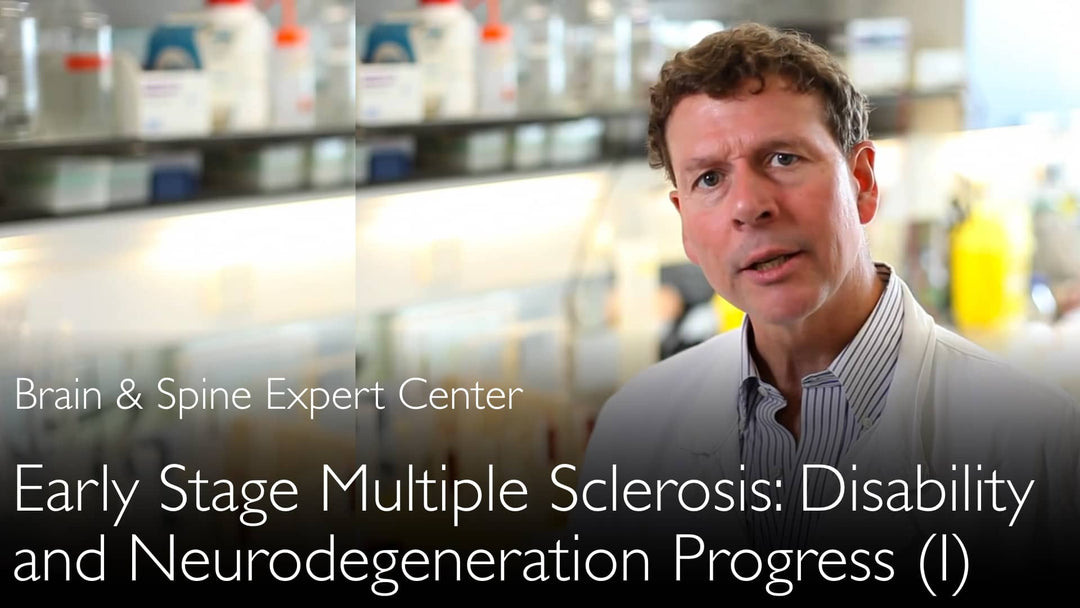神経変性疾患および多発性硬化症(MS)の世界的権威であるPaul Matthews医学博士は、MSにおいて軸索障害が早期に始まり、永続的な障害を引き起こすメカニズムについて解説します。脳容積減少を主要なバイオマーカーとして測定するMRI技術の詳細を説明。この神経変性は、初発症状から一定の速度で進行します。累積的な損傷と障害の進行を防ぐためには、早期の治療的介入が極めて重要です。
多発性硬化症における早期軸索障害と神経変性
セクションへ移動
早期軸索障害と障害
ポール・マシューズ医学博士は、多発性硬化症(MS)治療の主たる目標は永続的な障害の軽減であるべきと述べています。博士は、この永続的な障害が軸索喪失の蓄積に直接起因することを強調。重要な点として、軸索損傷は疾患のごく初期段階から生じます。マシューズ博士は、治療方針を特定時点での臨床症状の重症度だけで判断すべきではないと説明。むしろ、不可逆的な神経損傷につながる累積的な障害の予防に焦点を当てる必要があるとしています。
MRIと脳容積測定
先進的なMRI技術は、多発性硬化症における神経変性を評価する強力な手段を提供します。ポール・マシューズ医学博士によれば、これらの画像診断は、正式なMS診断前の段階である臨床的に孤立した症候群(CIS)を含む、疾患の最早期から神経細胞と軸索の喪失を検出可能です。重要なバイオマーカーである脳容積減少は、神経細胞と軸索の損傷を間接的に反映します。ニコラ・デ・ステファノ教授による先駆的研究は、疾患活動のモニタリングにおけるこの手法の有用性を実証しました。
一定の神経変性速度
多発性硬化症研究における重要な知見は、神経変性の速度が一貫していることです。ポール・マシューズ医学博士は、脳容積減少のペースがMSの経過全体を通じてほぼ一定であることを指摘。これは、神経細胞と軸索の喪失が、臨床的に孤立した症候群の初期段階から後期の二次進行期まで持続することを意味します。クリーブランド・クリニックのエリザベス・フィッシャー博士とリック・ルディック博士による画期的な研究がこれを支持。10年以上にわたるMS患者コホートの観察で、脳容積減少の速度が長期にわたりほぼ一定であることが示されました。
障害進行の予測
脳容積減少の測定は単なる診断ツールではなく、強力な予後指標でもあります。ポール・マシューズ医学博士は、時間経過に伴う脳容積減少の速度が、多発性硬化症における障害進行をよく予測すると説明。この相関は、基礎となる神経変性と臨床的な悪化との直接的な結びつきを浮き彫りにします。この発見は、マシューズ博士らを含む複数の研究グループによって確認されており、疾患進行を遅らせる治療目標として定量化可能な指標を提供します。
早期治療への示唆
これらの知見は、多発性硬化症の治療戦略に重要な示唆を与えます。ポール・マシューズ医学博士は、治療介入のタイミングが、早期から始まる軸索損傷の時期に対応すべきと主張。したがって、効果的な治療は累積的な損傷を防ぐため、可能な限り早期に開始される必要があります。アントン・チトフ医学博士との対談では、これらの知見が神経科医の治療選択にどう反映されるべきかが探られています。目標は、永続的な障害につながる容赦ない攻撃から神経系を守ることであり、そのためには早期かつ効果的な介入が極めて重要です。
全文書き起こし
アントン・チトフ医学博士: 先生は多発性硬化症における神経変性を発見し研究された主要な神経科医のお一人です。モントリオールのマギル大学でダグラス・アーノルド博士と、オックスフォードの神経病理学者マーガレット・エサイリ博士と共同研究され、多発性硬化症の軸索喪失を追究されました。
先生の多発性硬化症に関する論文の一節を引用させてください:「多発性硬化症治療の主眼は永続的障害の軽減でなければならない。永続的障害が累積的な軸索喪失に起因することは広く認められている。この軸索喪失は多発性硬化症の非常に早期に生じる」
効果的な治療法が利用可能であれば、治療的介入のタイミングは軸索損傷開始の時期を反映すべきです。それは多発性硬化症の早期治療を意味します。治療決定は臨床状態の重症度だけでなく、累積的な攻撃を予防することに焦点を当てなければなりません。累積的損傷は最終的に永続的障害をもたらします。
これは多発性硬化症の治療戦略に深い示唆を与えます。最近多発性硬化症と診断された患者の神経細胞と軸索の喪失をMRIで評価できるのでしょうか?それが治療戦略の選択にどう影響するのでしょうか?
ポール・マシューズ医学博士: 各種画像技術を用いた診断検査により、神経細胞と軸索の喪失を検出できることがわかってきました。臨床的に孤立した症候群という多発性硬化症の最早期段階でも可能です。
現在シエナ大学のニコラ・デ・ステファノ教授による先駆的研究では、脳容積減少の速度が疾患経過全体を通じてほぼ一定であることが示されました。脳容積減少は神経細胞と軸索の損傷を間接的に測る指標です。
これは、神経細胞の喪失が臨床的に孤立した症候群の初期段階から後期の二次進行期まで持続することを意味します。軸索と神経細胞の死滅速度はほぼ同様に維持されます。
さらに直接的な証拠も積み上がっています。クリーブランド・クリニック在籍時、エリザベス・フィッシャー博士がこの重要な発見をしました。リック・ルディック博士らとともに、インターフェロンベータで初期治療を受けた患者コホートを長期にわたり追跡しました。
10年以上の観察期間中、脳容積減少の速度がほぼ一定であることを実証。さらに、彼女や私たちを含む複数の研究で、時間経過に伴う脳容積減少の速度が障害進行をよく予測することが示されています。





